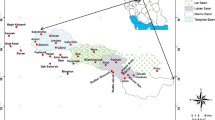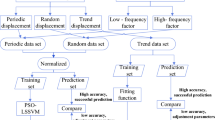Abstract
Rainfall is one of the main factors that influence the stability of slopes. However, rainfall data have some common features, such as huge data volume and difficulties in direct use. Currently, measurements such as daily rainfall, total rainfall volume and rainfall intensity are widely used for rainfall data feature extraction, which weakens the comprehensive impact of rainfall on slope stability. A feature extraction method for rainfall data is proposed in this paper. Rainfall data is transformed into feature matrices, which have much smaller data volumes. These feature matrices contain lots of useful information and can be used directly in landslide analyses. Based on the statistics of each of the rainfall events, this article applies K-means to classify these events. By dividing rainfall volume into categories of evaporation, infiltration and runoff, feature extraction is conducted. To quantitatively analyze the comprehensive impact of rainfall on landslide stability, Particle Swarm Optimization (PSO) is utilized to search for an array of weight coefficients for evaporation, infiltration and runoff under various rainfall types, which eventually leads to the feature extraction of rainfall data. This feature extraction method is applied to the rainfall data feature analysis of the Baishuihe landslide area. The rationality and validity of the method are verified by the results of landslide displacements predicted by Back-Propagation (BP) neural network. This study provides an effective rainfall data feature extraction method and a new direction for quantitative analysis of landslide monitoring data.









Similar content being viewed by others
References
Agustoni S (1996) Precipitazioni in grado di innescare frane e flussi di detrito nella regione del Cantone Ticino. Dipartimento del territorio Divisione pianificazione
Aleotti P (2004) A warning system for rainfall-induced shallow failures. Eng Geol 73(3):247–265
Ali A, Huang J, Lyamin AV, Sloan SW, Griffiths DV, Cassidy MJ, Li JH (2014) Simplified quantitative risk assessment of rainfall-induced landslides modelled by infinite slopes. Eng Geol 179(10):102–116
Barry DA, Parlange JY, Haverkamp R, Ross PJ (1995) Infiltration under ponded conditions: 4. an explicit predictive infiltration formula. Soil Sci 160(1):8–17
Brand EW, Premchitt J, Phillipson HB (1984) Relationship between rainfall and landslide in HongKong. In: Proceeding 4th International Symposium Landslides, Toronto, 17 September 1:377–384
Caine N (1980) The rainfall intensity: duration control of shallow landslides and debris flows. Geogr Ann 62(1/2):23–27
Canuti P, Focardi P, Garzonio CA (1985) Correlation between rainfall and landslides. Bull Inter Assoc Eng Geol—Bulletin de l’Association Internationale de Géologie de l’Ingénieur 32(1):49–54
Chen H, Lee CF (2003) A dynamic model for rainfall-induced landslides on natural slopes. Geomorphology 51(4):269–288
Crozier MJ, Eyles RJ (1980) Assessing the probability of rapid mass movement. In: Third Australia-New Zealand conference on Geomechanics: Wellington, May 12-16 2-47-2-51
Eberhart R, Kennedy J (1995) A new optimizer using particle swarm theory. In: Proc 6th Int Symp on Micro Machine and Human Science, Nagoya, Japan, 4–6 Oct pp 39–43
Glade T (2000) Modelling landslide triggering rainfall thresholds at a range of complexities. In: Proc of the VIII International Symposium on Landslides, Cardiff vol. 2, Telford, London 633–640
Glade T, Crozier M, Smith P (2000) Applying probability determination to refine landslide-triggering rainfall thresholds using an empirical “antecedent daily rainfall model”. Pure appl Geophys 157(6–8):1059–1079
Govi M, Sorzana PF (1980) Landslide susceptibility as function of critical rainfall amount in Piedmont basin (North-Western Italy). Stud Geomorphol Carpatho-Balc 14:43–61
Guidicini G, Iwasa OY (1977) Tentative correlation between rainfall and landslides in a humid tropical environment. Bull Int Assoc Eng Geol—Bulletin de l’Association Internationale de Géologie de l’Ingénieur 16(1):13–20
Ham, Dae H (2014) Review of landslide forecast standard suitability by analysing landslide-inducing rainfall. J Korean Soc Hazard Mitig 14(3):299–310
Han W (2012) Monitoring and theoretical analysis of rainfall infiltration of huangtupo landslide in the three gorges reservoir. China University of Geosciences for the Master Degree of Engineering
Innes JL (1983) Debris flows. Prog Phys Geogr 7:469–501
Jean L, Zeller J, Geiger H, Rothlisberger G (1977) Starkniederschläge des schweizerischen Alpen und Alpenrandgebietes (Fortes précipitations dans les Alpes suisses et les régions voisines). Revue De Géographie Alpine 65:227–228
Jun KW, Oh CY, Lee SY, Park GS, Ohga S (2015) Analysis of landslide risk area susceptibility using GIS: a case study of Injegun, Gangwondo, South Korea. J Fac Agri Kyushu Univ 60:43–50
Kim SW, Chun KW, Otsuki K, Shinohara Y, Kim MI, Kim MS (2015) Heavy rain types for triggering shallow landslides in South Korea. J Fac Agri Kyushu Univ 60:243–249
Lainas S, Sabatakakis N, Koukis G (2015) Rainfall thresholds for possible landslide initiation in wildfire-affected areas of western Greece. Bulletin of Engineering Geology and the Environment 1–14
Larsen MC, Simon A (1993) A rainfall intensity-duration threshold for landslides in a humid-tropical environment, Puerto Rico. Geografiska Annaler 75(1/2):13–23
Mein RG, Larson CL (1973) Modeling infiltration during a steady rain. Water Resour Res 9(2):384–394
Miller S, Brewer T, Harris N (2009) Rainfall thresholding and susceptibility assessment of rainfall-induced landslides: application to landslide management in St Thomas, Jamaica. Bull Eng Geol Environ 68(4):539–550
Mohamad ET, Armaghani DJ, Momeni E (2015) Prediction of the unconfined compressive strength of soft rocks: a PSO-based ANN approach. Bull Eng Geol Environ 74:745–757
Okada Y, Kurokawa U (2014) Examining effects of tree roots on shearing resistance in shallow landslides triggered by heavy rainfall in Shobara in 2010. J Forest Res 20(1):230–235
Onodera T, Yohinaka R, Kazama H (1974) Slope failures caused by heavy rainfall in Japan. J Japan Soc Eng Geol 11:1–10
Pedrozzi G (2004) Triggering of landslides in Canton Ticino (Switzerland) and prediction by the rainfall intensity and duration method. Bull Eng Geol Environ 63(4):281–291
Pradhan B, Lee S (2009) Regional landslide susceptibility analysis using back-propagation neural network model at Cameron Highland, Malaysia. Landslides 7(1):13–30
Pradhan B, Lee S (2010) Landslide susceptibility assessment and factor effect analysis: backpropagation artificial neural networks and their comparison with frequency ratio and bivariate logistic regression modelling. Environ Model Softw 25(6):747–759
Rokbani N, Abraham A, Alimil AM (2013) Fuzzy Ant Supervised by PSO and simplified ant supervised PSO applied to TSP. Hybrid Intelligent Systems (HIS), 2013 13th International Conference on. IEEE 251–255
Smith RE, Corrado C, Florisa M (1993) Modeling infiltration for multistorm runoff events. Water Resour Res 29(1):133–144
Starkel L (1979) The role of extreme meteorological events in the shaping of mountain relief. Geografica Polonica 41:13–20
Sun HY, Wong LNY, Shang YQ, Shen YJ, Lü Q (2010) Evaluation of drainage tunnel effectiveness in landslide control. Landslides 7(4):445–454
Tang H, Li C, Hu X, Wang L, Criss R, Su A, Wu Y, Xiong C (2014) Deformation response of the Huangtupo landslide to rainfall and the changing levels of the Three Gorges Reservoir. Bulletin of Engineering Geology & the Environment 1–10
Vassallo R, Grimaldi GM, Maio CD (2014) Pore water pressures induced by historical rain series in a clayey landslide: 3D modeling. Landslides 12:1–14
Wang L, Hwang JH, Luo Z, Juang CH, Xiao J (2013) Probabilistic back analysis of slope failure—A case study in Taiwan. Comput Geotech 51:12–23
Wilson RC, Torikai JD, Ellen SD (1992) Development of rainfall thresholds for debris flows in the Honolulu District, Oahu. US Geological Survey Open-File Report 45
Yang IT, Park JK, Jeon WH, Chun KS (2007) An Evaluation of Landslide Probability by Maximum Continuous Rainfall in Gangwon, Korea. J Korean Soc Geosp Infor Syst 15(4):11–20
Žibret G, Komac M, Jemec M (2012) PSInSAR displacements related to soil creep and rainfall intensities in the Alpine foreland of western Slovenia. Geomorphology 175–176:107–114
Acknowledgments
This research is funded by the National Natural Sciences Foundation of China (No.41302278), (No.41272377) and (No. 41272306), and the fund of Engineering Research Center of Rock-Soil Drilling & Excavation and Protection, Ministry of Education (No. 2010078025), and the Central Colleges of basic scientific research projects special fund operating expenses (No.CUGL100227). We would like to thank Zhangjiachong Soil and Water Conservation Experiment Station in Zigui County for providing the rainfall data. The first author is very grateful to the China Scholarship Council for funding this research.
Author information
Authors and Affiliations
Corresponding author
Rights and permissions
About this article
Cite this article
Liu, Y., Liu, D., Qin, Z. et al. Rainfall data feature extraction and its verification in displacement prediction of Baishuihe landslide in China. Bull Eng Geol Environ 75, 897–907 (2016). https://doi.org/10.1007/s10064-015-0847-1
Received:
Accepted:
Published:
Issue Date:
DOI: https://doi.org/10.1007/s10064-015-0847-1




